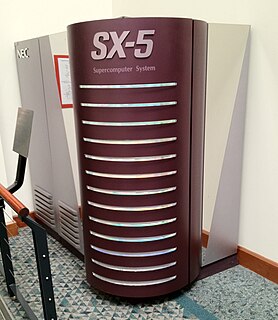| Look up supercomputer in Wiktionary, the free dictionary. |
A supercomputer is a computer with a high level of performance as compared to a general-purpose computer.
Supercomputer may also refer to:
| Look up supercomputer in Wiktionary, the free dictionary. |
A supercomputer is a computer with a high level of performance as compared to a general-purpose computer.
Supercomputer may also refer to:

Seymour Roger Cray was an American electrical engineer and supercomputer architect who designed a series of computers that were the fastest in the world for decades, and founded Cray Research which built many of these machines. Called "the father of supercomputing", Cray has been credited with creating the supercomputer industry. Joel S. Birnbaum, then chief technology officer of Hewlett-Packard, said of him: "It seems impossible to exaggerate the effect he had on the industry; many of the things that high performance computers now do routinely were at the farthest edge of credibility when Seymour envisioned them." Larry Smarr, then director of the National Center for Supercomputing Applications at the University of Illinois said that Cray is "the Thomas Edison of the supercomputing industry."

A supercomputer is a computer with a high level of performance as compared to a general-purpose computer. The performance of a supercomputer is commonly measured in floating-point operations per second (FLOPS) instead of million instructions per second (MIPS). Since 2017, there are supercomputers which can perform over 1017 FLOPS (a hundred quadrillion FLOPS, 100 petaFLOPS or 100 PFLOPS).

In computing, floating point operations per second is a measure of computer performance, useful in fields of scientific computations that require floating-point calculations. For such cases, it is a more accurate measure than measuring instructions per second.
Portal often refers to:

System X was a supercomputer assembled by Virginia Tech's Advanced Research Computing facility in the summer of 2003. Costing US$5.2 million, it was originally composed of 1,100 Apple Power Mac G5 computers with dual 2.0 GHz processors. System X was decommissioned on May 21, 2012.
Anton may refer to:
Steve Chen is a Taiwanese computer engineer and internet entrepreneur.
SUPER-UX is a version of the Unix operating system from NEC that is used on its SX series of supercomputers.

NEC SX describes a series of vector supercomputers designed, manufactured, and marketed by NEC. This computer series is notable for providing the first computer to exceed 1 gigaflop, as well as the fastest supercomputer in the world between 1992–1993, and 2002–2004. The current model, as of 2018, is the SX-Aurora TSUBASA.

The Centre for Development of Advanced Computing (C-DAC) is an Indian autonomous scientific society, operating under the Ministry of Electronics and Information Technology.

Vijay Pandurang Bhatkar is an Indian computer scientist, IT leader and educationalist. He is best known as the architect of India's national initiative in supercomputing where he led the development of Param supercomputers. He is a Padma Bhushan, Padma Shri and Maharashtra Bhushan awardee. Indian computer magazine Dataquest placed him among the pioneers of India's IT industry. He was the founder executive director of C-DAC and is currently working on developing Exascale supercomputing mission for India.
DGSCA, a.k.a. Computo Academico UNAM, previously known as PUC. It is the leading organization within the UNAM for computer technologies systems and held the distinction for being the first institution in México to install and operate a Cray Y-MP super computer, in early 1990.
The Center for Computation and Technology (CCT) is an interdisciplinary research center located on the campus of Louisiana State University in Baton Rouge, Louisiana.

The TOP500 project ranks and details the 500 most powerful non-distributed computer systems in the world. The project was started in 1993 and publishes an updated list of the supercomputers twice a year. The first of these updates always coincides with the International Supercomputing Conference in June, and the second is presented at the ACM/IEEE Supercomputing Conference in November. The project aims to provide a reliable basis for tracking and detecting trends in high-performance computing and bases rankings on HPL, a portable implementation of the high-performance LINPACK benchmark written in Fortran for distributed-memory computers.

A computer cluster is a set of computers that work together so that they can be viewed as a single system. Unlike grid computers, computer clusters have each node set to perform the same task, controlled and scheduled by software.

Tianhe-I, Tianhe-1, or TH-1 is a supercomputer capable of an Rmax of 2.5 peta FLOPS. Located at the National Supercomputing Center of Tianjin, China, it was the fastest computer in the world from October 2010 to June 2011 and was one of the few petascale supercomputers in the world.
Galileo Galilei (1564–1642) was a scientist and philosopher.
Turing is the codename for a graphics processing unit (GPU) microarchitecture developed by Nvidia. It is named after the prominent mathematician and computer scientist Alan Turing. The architecture was first introduced in August 2018 at SIGGRAPH 2018 in the workstation-oriented Quadro RTX cards, and one week later at Gamescom in consumer GeForce RTX 20 series graphics cards. Building on the preliminary work of its HPC-exclusive predecessor, the Turing architecture introduces the first consumer products capable of real-time ray tracing, a longstanding goal of the computer graphics industry. Key elements include dedicated artificial intelligence processors and dedicated ray tracing processors. Turing leverages DXR, OptiX, and Vulkan for access to ray-tracing. In February 2019, Nvidia released the GeForce 16 series of GPUs, which utilizes the new Turing design but lacks the ray tracing and artificial intelligence cores.